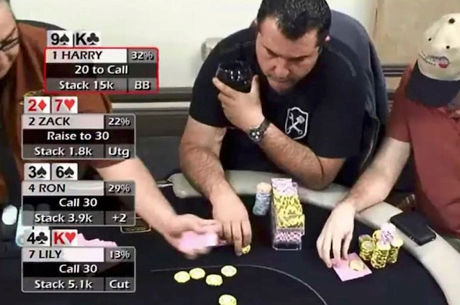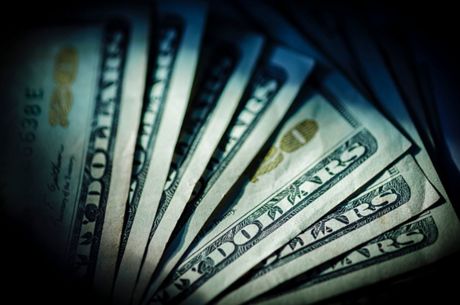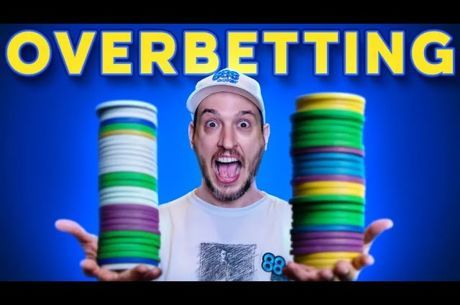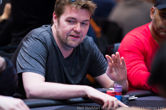Donkey Poker: When Can I Take a Bathroom Break?
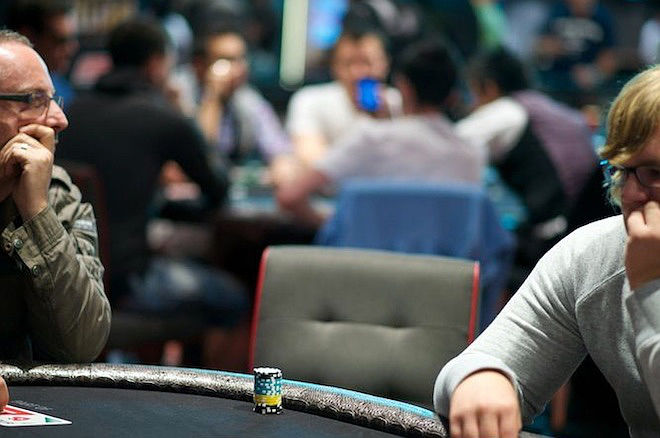
A couple of years ago I was attending the Wednesday Poker Discussion Group in Las Vegas — held each Wednesday at 3 p.m. at Ricardo's in Las Vegas — when a curious question came up.
"What is the best time to get up from the table to visit the restroom?"
It's an interesting question that actually has a mathematically correct answer.
The answer may seem obvious to a good player. Even so, I am often surprised when players get up for a quick break. Only rarely will they miss their button, but some have no problem missing their cutoff and hijack hands. Let's look a little closer and see just how expensive this can be.
The "Blinds Tax"
My previous article "Are You a Position-Dummy?" showed the huge value of position in no-limit hold'em. Poker is an information game. The better our position, the better information we have.
Consider the top curve shown below in Figure PN4-1, which shows the average profit made from each position by "veteran" online NL50 and NL100 players. The veterans are the 2,000 players in my 130,000-player database who have played the most hands. Mr. Veteran is much better, on average, than the average online player.
We can see that Mr. Veteran is profitable from every table position except the blinds. If we extrapolate the curve to the left (the dashed line), we can see that the he would even be profitable from both blinds if he didn't have to post them.
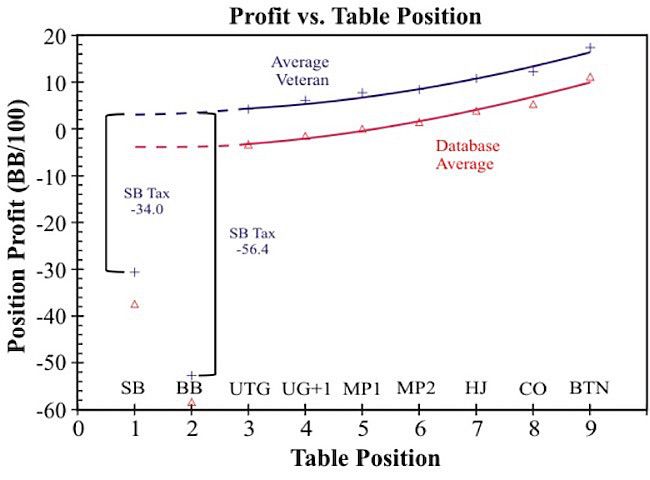
Mr. Veteran loses about 53 BB per hundred big blinds played, or about 0.53 BB per hand. But the dashed line implies that he would have won about 4 BB/100 if the 1 BB had been posted by someone else.
I like to call the gap between the extrapolated line and the actual loss the "blinds tax." The sum of both blinds taxes is about 0.9 BB, or about 60% of the actual cost of both blinds. (This is less than the full 1.5 BBs actually posted, since we sometimes get to play the big blind for free or the small blind at a discount.)
It doesn't matter when we pay the blinds tax. Suppose the rules were changed such that the small blind posted the entire 1.5 BBs. Then the BB profit would be about 4 BB/100 (on the dashed line) and the SB profit would drop by about 56 BB/100 hand. We can consider this blinds tax to be dead money once it is placed in the pot.
Notice that the total blinds tax is nearly the same for Mr. Veteran as it is for the Mr. Average. This suggests that the general trend for live, low-stakes players should be similar, even if the precise amount of the tax is slightly different. The lesson here is clear:
The blinds tax is the same, from wherever we post it.
The Value of Early Position
Now let's compare the average profit by Mr. Veteran in various table positions with the extrapolated profit in the blinds. Figure PN4-2 below shows the data used to create Figure PN4-1.
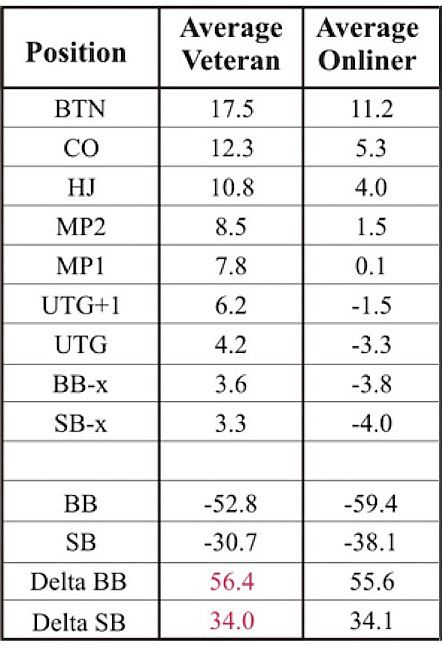
Suppose Mr. Veteran misses his small blind, returns to the table, and then posts his 0.5 BB from the cutoff. (When missing a small blind, we are not generally allowed to buy the button.) So Mr. Veteran has missed two spots, the SB and BTN, costing a total of 17.5 + 3.3 = 20.8 BB/100 on average.
But suppose Mr. Veteran plays his UTG hand, misses his big blind, and then posts 1.5 BB from the small blind position. Now he is missing just the 3.6 BB profit he normally makes playing the big blind (exclusive of his 1 BB post). This is a huge contrast from the first scenario.
The conclusion we can make is:
Never miss your button!
But Figure PN4-2 makes it clear that we should also never miss our cutoff and hijack seats, since these are also very profitable positions. In fact, these three positions generate nearly all of the profit for Mr. Average.
So When Can I Pee?
These conclusions should hold just as well for low-stakes Vegas no-limit hold'em cash games, even though the average Donkey Gamer is much worse than the average online NL100 player. (See "Low-Stakes Games Differ From Online" for a definition of "Donkey Games.")
A break-even player is certainly unprofitable from the blinds, even excluding his posts. And he is probably also unprofitable from UTG, UTG+1 and even the middle positions. This means that missing his UTG, UTG+ and BB hands would actually improve his overall profit. For most Donkey Gamers, the best strategy may be to play MP1, take a short break, and then return to play your small blind.
My local Vegas card room uses automatic shufflers, averaging about 40 hands/hour, or about 2.5 minutes per hand. The restrooms are nearby, so I generally only need a few minutes. So I will usually leave after folding my UTG hand, missing just a single hand and returning in time to buy the button from the small blind position. Since am I probably profitable from every position (excluding posts), I try to miss as few hands as possible.
- Low-Stakes Live Games Differ from Online
- Do You Play Too Many Hands?
- Are You a Position-Dummy?
- Is Straddling a Good or Bad Play?
- A Preflop Question: Is Limping Lame?
- Maximizing Expectation When Betting For Value
- Maximizing Expectation When Betting as a Bluff
- Five Weak Reasons to Bet (and One Weak Reason Not To)
- Do You Have 'Jack-O-Phobia'? Playing Pocket Jacks in Live NL Hold'em
Steve Selbrede has been playing poker for 20 years and writing about it since 2012. He is the author of five books, The Statistics of Poker, Beat the Donks, Donkey Poker Volume 1: Preflop, Donkey Poker Volume 2: Postflop, and Donkey Poker Volume 3: Hand Reading.
In this Series
- 1 Donkey Poker: Low-Stakes Live Games Differ from Online
- 2 Donkey Poker: Do You Play Too Many Hands?
- 3 Donkey Poker: Are You a Position-Dummy?
- 4 Donkey Poker: When Can I Take a Bathroom Break?
- 5 Is Straddling a Good or Bad Play?
- 6 A Preflop Question: Is Limping Lame?
- 7 Maximizing Expectation When Betting For Value
- 8 Maximizing Expectation When Betting as a Bluff
- 9 Five Weak Reasons to Bet (and One Weak Reason Not To)
- 10 Do You Have 'Jack-O-Phobia'? Playing Pocket Jacks in Live NL Hold'em
- 11 Donk Betting in Small-Stakes Live No-Limit Hold'em

